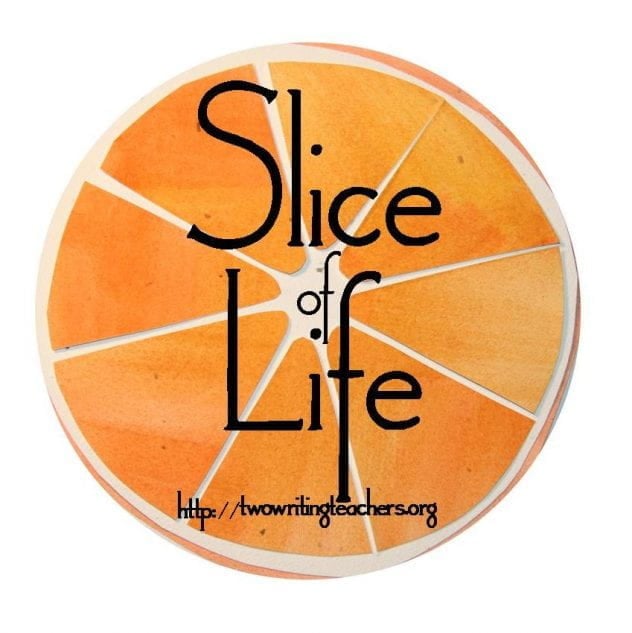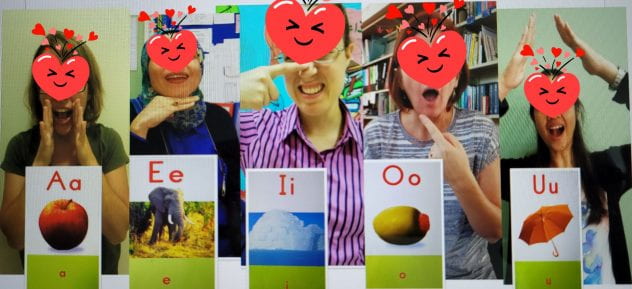
Tomorrow I will start a new fourth grade small group tutoring club for some English language learners. In the pretest, I noticed they didn’t acknowledge the long vowel in silent e nonsense words.
In addition, these fourth graders’ pre assessments showed a lack of variety in the vowel sounds for the cvc words they pronounced. We have always had difficulty teaching so many vowel sounds to our students. Arabic has only 8 vowel/diphthongs and English has 22 different vowels and diphthongs. We really notice it when trying to teach the short vowel sounds. For instance, even for native English speakers, the differences between /i/ and /e/ are subtle.
We have created some visual cues to help the children. These have proven helpful to children with spelling. Rather than just tell them the letter names of “regular”-sounding words, we tell them the sounds in the word as we use the visual cues, which are also hanging on posters in the room for them to refer to at all times.

Another important reason for us all to have a unique visual cue for each of these vowels is the fact that each teacher brings his or her own unique English accent from Egypt, India, Uganda, U.S.A., Sri Lanka, Philippines, Canada, England, and more countries over the years.
Today I wrote some poems, which I may bring to my fourth grade students. I found it fun thinking about these little tricksters and writing these poems today. I used a Fibonacci sequence to 13 and then backwards to one syllable.
Short Vowels
Now
Read
Short words
c-v-c
Sounds like apple /a/
Elephant /e/, igloo /i/, Whee!
Olive /o/ and umbrella /u/ – Try one of these sounds
When a c-v-c word you see–
pap, pep, pip, pop, pup
There’s the key
To c
v
c
Long Vowels
You
know
letter
names to Z–
Great big silent e
Quietly changes c-v-c
Say their name sounds now: A, E, I, O, and U, you see–
blaze, these, ripe, rope, ruse–try some more:
mame, meme, mime, mome, mume
Silly, still
Silent
E
Shouts
How clever! Your poems are great. I wonder if my students would be interested in an interactive or shared writing of a similar poem. Also, I really like your visual cues posters. Vowels are so tricky. I teach second grade. Thanks for sharing your slice!
Meredith, thank you for stopping by. I taught grade 2 for seven years at three different schools. They definitely have a piece of my heart!
Silent E shouts! Yes it does! I love the way you’re looking for new ways to teach vowel sounds and I bet these will help!
Thank you, Ruth! Yes, I want silent 3 to shout a little louder to those who don’t see it.
Denise,
This is such a clever way to teach vowel sounds. I also love the visual cues. That reminds me of teaching prepositions to ELLs by performing them.,
Thank you, Glenda. I’m sure you made performing prepositions a joy to behold!
This is so wonderful! Specially the ‘Silent E Shouts’. Makes me want to write something to help my high school learners with valency, I teach Chemistry. Loved it thoroughly!
Oh, that sounds awesome! And then maybe they can write some too! Recently I had high school sociology students writing beautiful poems about social problems.
I’m totally going to use this with my son who is 4.5. Thanks for sharing them here!
Thanks, Stacey. I appreciate the vote of confidence.
Denise! This is incredible! You are going to really excite your students, I have no doubt. They are going to love this!
Thanks, Maureen. I wasn’t sure I would use them, but now I have decided I will.
Denise, as a former districtwide director of ELA and ESL, I am delighted to see your Fib poems and the heart emoji visuals. I think you should share these visuals on Twitter for other ESL teachers to use.
Thank you, Carol. After your comment i sent this post to the Tesol blog to see if it could be shared there.
Wow, what a great post! I love the way you’ve come up with visual cues to help your students–that’s fantastic. Next year I’m moving into a 4th grade position (coming from a science coaching position), and I’ve already had someone say “I was lucky because I didn’t have to teach kids how to read.” Now, I don’t have a large ELL population, but I still have a hunch there will be some phonics/decoding instruction in my school day.
Thanks for sharing some great ideas!
Thank you, Tim. Enjoy that be grade level. What fun! Yes, there are always reminders for grade 4 too. Actually any age can benefit from remembering these general rules when spelling words like starring and staring, for instance.